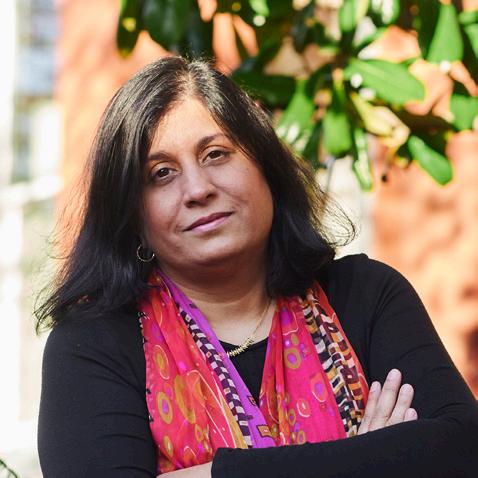
4 minute read
Trailblazing a New Path in STEM
from SEEMA Magazine
by SEEMA
There was a time when a “woman who worked” evoked several unpleasant notions: that it was improper, her husband (or parents) couldn’t provide for her, that she was neglecting her domestic life, and worse. Any woman who wanted to pursue her passion and intellect for science, technology, engineering or mathematics (STEM), had to make her way against the grain, taking risks and often putting up with a lot of barriers visible and invisible. Maybe they wouldn’t get paid equally. Or maybe they had to put up with colleagues making derisive comments or undermining their participation.
The story of women in STEM has always, and continues to be one of great courage and perseverance. Research shows that women who enter Ph.D. programs in which they have no female peers are 12 percentage points less likely to graduate than men in the same program. Even today, according to UNESCO Institute for Statistics (UIS) data, less than 30% of the world’s researchers are women. It remains a remarkable achievement for a woman, particularly a woman of color, to make a happy, rewarding career in STEM today.
Take for example, the starting salaries of engineering graduates: on average, women with engineering degrees earn less than $61,000 annually, while men earn above $65,000 annually. Just maybe, that’s why only 38% of women who major in computers go on to work in computer fields, and only 24% of those who majored in engineering work in the engineering field.
Research also shows that women in STEM are seldom in positions of power and leadership; and more likely than men to work in the lower-paying “STEM periphery” — roles in which they can apply STEM skills and expertise, but aren’t traditional STEM occupations.
STEM disciplines are about pushing boundaries, expanding the frontiers of knowledge, and in many cases, saving the world: but women in STEM have to shatter glass ceilings, constantly prove themselves, and smash the patriarchy while they’re at it. And for those who make the choice to partner up and have children while pursuing the careers they’ve been dreaming about, the challenges to remain working are immense — and this is true for women in every field. Fortunately, there is no dearth of women who are up to the challenge. Swati Mohan has played key roles on teams that put spacecrafts on the Moon, Saturn and more recently, on Mars. While working on the Mars 2020 mission, Mohan gave birth to her second child.
SEEMA has also recognized a few of the most iconic South Asian achievers recently: physicistphysician Dr Anita Goel, biotech entrepreneur Sangeeta Bhatia, and the wonderful multi-hyphenated Maya Ajmera, who is, among other things, CEO of the Society for Science & the Public. These women, beyond their achievements in their own fields, are also fantastic advocates for young women in science.
Although women’s participation in science and technology professions is increasing, there is a tremendous amount of work to be done. Gendered notions of STEM professions start young. Studies involving school-age children show a worrying trend: that their image of a “scientist” is usually a middle-aged or elderly man in a white lab-coat; and that they perceive science to be a “masculine” profession. “I don’t look like your typical scientist,” 15-year-old Gitanjali Rao, TIME’s first ever “Kid of the Year” told Angelina Jolie in an interview. “Everything I see on TV is that it’s an older, usually white man as a scientist... It’s not easy when you don’t see anyone else like you.” Children need to see female and female-identifying scientists, engineers and doctors on TV, in movies and even around them.
It’s not all doom and gloom, though. With several organizations and individuals committed to empowering women, investing in research and scholarships, and expanding diversity and inclusion initiatives, things are improving steadily. But, it’s still a revolution, a battle. And luckily, women are experts at the time-tested technique of winning: lifting each other up.
PRATIKA YASHASWI
Anita Goel, physicistphysician, chairman and CEO, Nanobiosym® (NBS) Research institute
“What Seema created with the SEEMA magazine and the SEEMA movement is a great encouragement in STEM and in many other ways for South Asians, by helping to inspire and set role models for the younger generation and integrating one’s heritage with one’s work and passions. All of our journeys are shaped by those types of experiences and to bring it all together creates a richness in the human experience and such an interesting canvas for people to see innovation and contribution for human society from all walks of life and cultures.”
Kaneenika Sinha, mathematician
“When I was in college...I started attending workshops outside of the college curriculum conducted by people who were researchers in the field of mathematics. That’s really when I realized that you can actually “do” mathematics for a living, and decided to pursue it.
“What we look towards is making sure the next generation of young people in this country are STEM ambassadors. Everything from our outreach and equity programs to Science News, they are the ones that we have to reach. What we realized is that science teachers needed excellent, evidencebased content for teaching. They didn’t know which sources to trust, and their textbooks are really old. In 2015, we piloted a program called ‘Science News in High Schools.’ After five years, we’re now in over 5,000 high schools across the country.”
Kamakshi Sivaramakrishnan, founder and CEO, Drawbridge
“Startups typically attract people who are very ambitious, somewhat of a misfit in other companies, who want to create an impact, be creative and entrepreneurial. This profile typically belongs to the old boys of the game,” says Sivaramakrishnan. Her advice to women wishing to make a mark in the tech world is to “be comfortable with the uncomfortable”.











